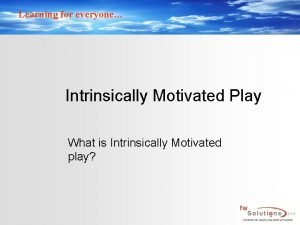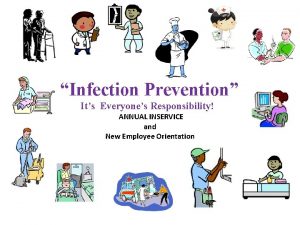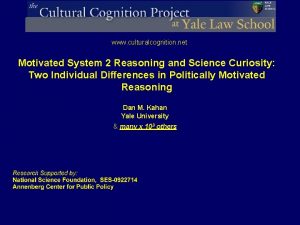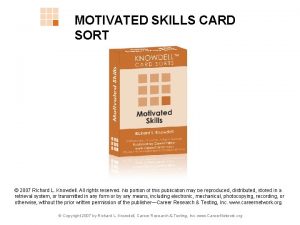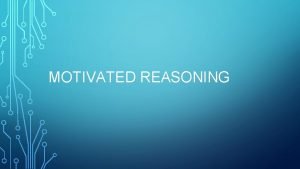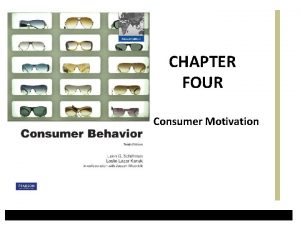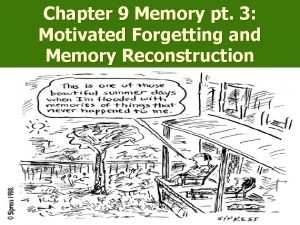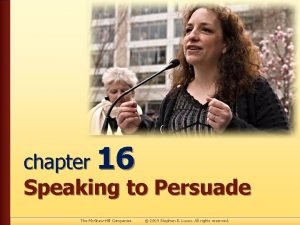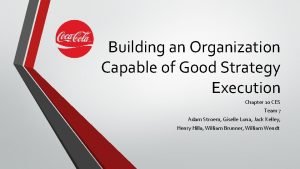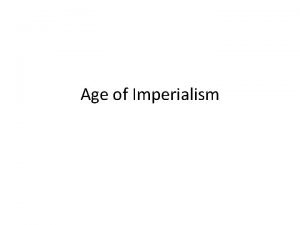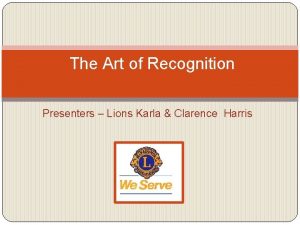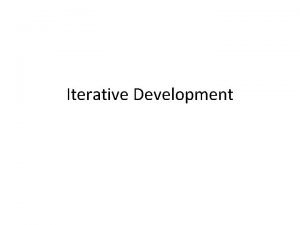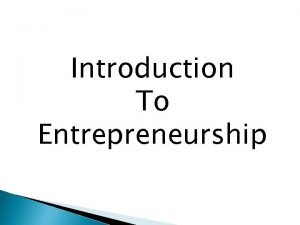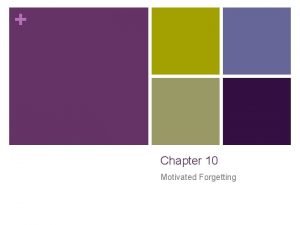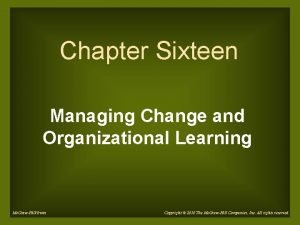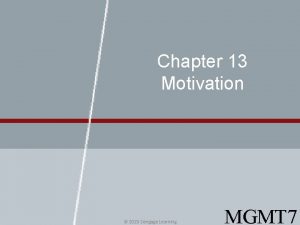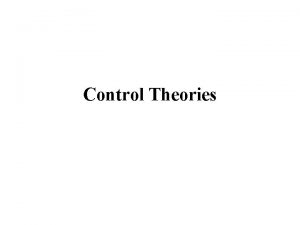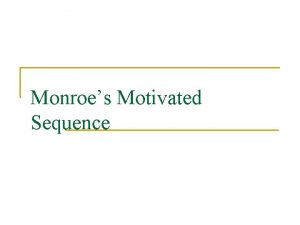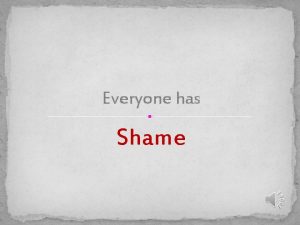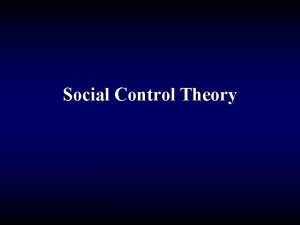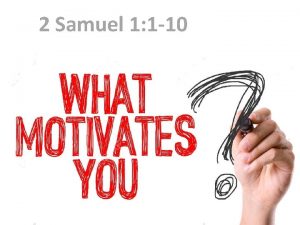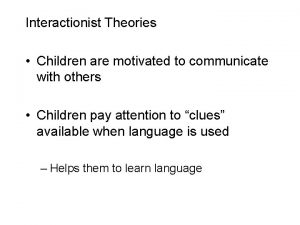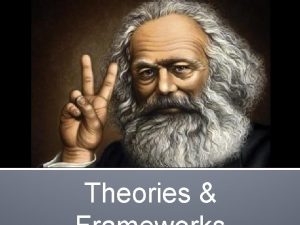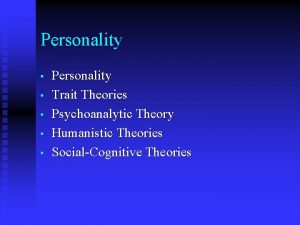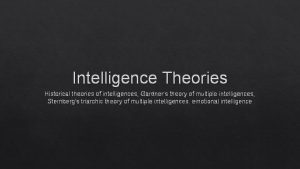Control Theories Control Theory Everyone is motivated to




















- Slides: 20

Control Theories

Control Theory • Everyone is motivated to break the law – So, the question is NOT: Why do we break rules? But, Why don’t we? • Deviance result from weak social constraints – A theory of conformity – Constraints originate in our social experience

Social Sources of Control • We connect to society via social groups – Family, neighborhood, and school – “We are moral beings only to the extent that we are social beings” Emile Durkheim (1925) • Social rewards become contingent on staying out of trouble – We develop stakes in conformity – “When you got nothing, you got nothing to lose” Bob Dylan

Hirschi’s Social Bond Theory • People break the law because they have not internalized society’s rules • Internalization requires strong social bonds to groups in society (family, school, job) – Social bonds do not reduce criminal motivation, they increase one’s ability to resist the temptation of crime

Hirschi’s Social Bond Theory • (Emotional) Attachment to conventional others, such as parents, teachers, and peers leads us to avoid their disapproval = source of conscience • (Material) Commitment to conformity, deviance places conventional investments at risk = rational choice • (Temporal) Involvement = opportunity – “idle hands are devil’s workshop” • (Moral) Belief in the rightness of conventional rules, and the degree to which they should be followed

Age-Graded Theory of Informal Social Control • Sampson and Laub (1993) extend Hirschi’s original bond theory • Attempt to explain change in offending over the life course – A developmental approach • Social bonds reduce adult crime – More optimistic than self-control theory – people can change!

Research Questions • Are there typical pathways to crime? • Once formed, can these pathways be altered? • Why are some delinquents able to turn their lives around while others are not?

The Life-Course Perspective • Trajectories = long-term pathways through life • Transitions = short-term events that affect life trajectories = turning points • Turning points facilitate role transition • Attending school -> employment -> career > marriage -> family

Age-Graded Theory of Informal Social Control • Social bonds foster informal control (Hirschi) • Parent-child, teacher-student, employeremployee – Tend to be age-graded – Affected by larger context, neighborhood, history • Weak social bonds = weak informal control – Weak bonds = weak commitments to others = few stakes in conformity = less to lose = deviance likely

Continuity and Change • Continuity – Prior delinquency reduces opportunities for social bonding • Contrast with low-self control theory • Change – Life transitions affect life trajectories • If they create interdependency and obligation • Bad relationships yield little informal social control

Empirical Evidence • Predictors of delinquency – Lack of bonds to family and school – Lack of parental discipline, supervision, attachment – Neighborhood conditions (poverty, family disruption) affect delinquency indirectly through family bonds • Change in adult bonds to work and family = decrease offending

Policy Implications: Foster and Protect Social Bonds • Job training and family counseling – Before and during prison • Less reliance on incarceration – Incarceration undermines work and family, which undermines informal social control • Use of community based punishment – Protect existing social bonds to work and family

Recent Developments: Low Self-Control Theory • Gottfredson and Hirschi (1990) – One cause of crime: low self-control • Self-control is formed in early childhood and remains stable throughout life • Restraint resides in the person, not in the relationship to social groups in society – In contrast to Hirschi

The Origins of Self-Control • Young children lie, push, hit, steal, cheat • By age 8 -10, kids learn to control these behaviors - self-control is achieved • Sources of learning self-control – Parenting is key – careful supervision and punishment for misbehavior – Natural sanctions – injuries, bruises, fear, pain

Low Self-Control Theory • Most people know right from wrong – Crime is a matter of human weakness • Most offenders offend repeatedly – Prior offending is best predictor of future crime – Emphasis on continuity in offending • Offenders tend to be generalists • Most offending requires no special skill • Offending usually brings immediate benefit, with the potential for long-term costs

Low-Self Control Theory • We are all born with low self control • High self-control is created in early childhood – Parental monitoring and punishment, set by age 8 -10 • People with low self-control yield to the temptation of immediate gratification • De-emphasize social/motivational factors – The cause is in the person • De-emphasize the rationality of criminal choices – Low self-control undermines rationality

A General Theory • Self-control is the only important causal factor • Other associations with crime are spurious (also due to self-control) – Failed marriages, unemployment, low education • Crime co-occurs with other immediately gratifying but high risk behaviors – Smoking, drinking, drug use, speeding, unprotected sex, accidents – All give pleasure with minimal effort

Age-Crime Curve • Individual differences in the propensity to offend remain stable over time • Regardless of initial starting point, everyone slows down with age

Tautological? • Low self-control = the willingness to engage in behaviors that bring immediate benefits, with the chance of long-term, negative consequences – Crime is defined as such behavior • How can low self-control predict crime when it is part of the definition of crime? • G&H do not see this as a problem, but rather an unfortunate fact of life

Policy Implications of Self-Control Theory • Focus on early family-based intervention – Formal CJ sanctions can play only a minor role • Increase immediate difficulties and risks of crime, not long-term risks – Situational crime prevention – crime specific • Restrict unsupervised youth activity for those with weak families
 Motivated learning for everyone
Motivated learning for everyone Hello hope you are doing well
Hello hope you are doing well Infection control is everyone's responsibility
Infection control is everyone's responsibility Motivated system 2 reasoning
Motivated system 2 reasoning Semantic satiation
Semantic satiation Skills card sort
Skills card sort Motivated reasoning
Motivated reasoning What were the 3 gs during the age of exploration
What were the 3 gs during the age of exploration Are the sought-after results of motivated behavior
Are the sought-after results of motivated behavior Define motivated forgetting
Define motivated forgetting Monroe's motivated sequence
Monroe's motivated sequence When are capabilities-motivated acquisitions essential?
When are capabilities-motivated acquisitions essential? Why did western nations desire lands in the pacific rim
Why did western nations desire lands in the pacific rim Lions are motivated by recognition
Lions are motivated by recognition Monroe's motivated sequence
Monroe's motivated sequence Motivated last thing you want do
Motivated last thing you want do Myth 3: entrepreneurs are motivated primarily by money
Myth 3: entrepreneurs are motivated primarily by money Define motivated forgetting
Define motivated forgetting When abigail threatens betty, abigail is motivated by her
When abigail threatens betty, abigail is motivated by her Which of the following forces motivated change at h&b
Which of the following forces motivated change at h&b Basic model of motivation
Basic model of motivation
